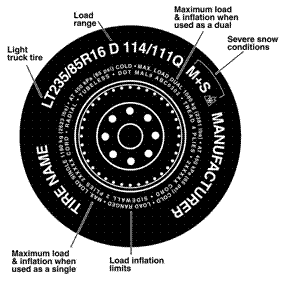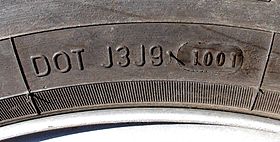
A tire or tyre is a ring-shaped component that surrounds a wheel's rim to transfer a vehicle's load from the axle through the wheel to the ground and to provide traction on the surface over which the wheel travels. Most tires, such as those for automobiles and bicycles, are pneumatically inflated structures, providing a flexible cushion that absorbs shock as the tire rolls over rough features on the surface. Tires provide a footprint, called a contact patch, designed to match the vehicle's weight and the bearing on the surface that it rolls over by exerting a pressure that will avoid deforming the surface.

A mountain bike (MTB) or mountain bicycle is a bicycle designed for off-road cycling. Mountain bikes share some similarities with other bicycles, but incorporate features designed to enhance durability and performance in rough terrain, which makes them heavier, more complex and less efficient on smooth surfaces. These typically include a suspension fork, large knobby tires, more durable wheels, more powerful brakes, straight, extra wide handlebars to improve balance and comfort over rough terrain, and wide-ratio gearing optimised for topography, application and a frame with a suspension mechanism for the rear wheel. Rear suspension is ubiquitous in heavier-duty bikes and now common even in lighter bikes. Dropper seat posts can be installed to allow the rider to quickly adjust the seat height.
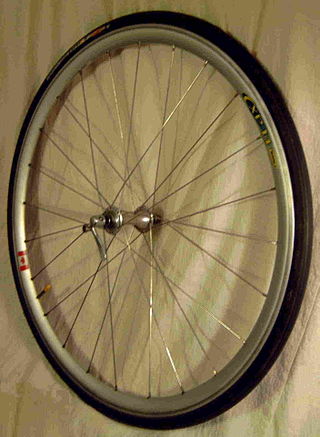
A bicycle wheel is a wheel, most commonly a wire wheel, designed for a bicycle. A pair is often called a wheelset, especially in the context of ready built "off the shelf" performance-oriented wheels.

A speedometer or speed meter is a gauge that measures and displays the instantaneous speed of a vehicle. Now universally fitted to motor vehicles, they started to be available as options in the early 20th century, and as standard equipment from about 1910 onwards. Other vehicles may use devices analogous to the speedometer with different means of sensing speed, eg. boats use a pit log, while aircraft use an airspeed indicator.
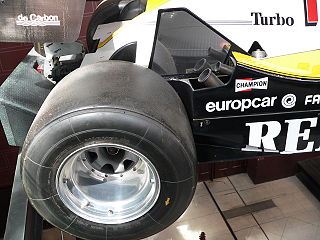
A racing slick or slick tyre is a type of tyre that has a smooth tread used mostly in auto racing. The first production slick tyre was developed by M&H Tires in the early 1950s for use in drag racing. By eliminating any grooves cut into the tread, such tyres provide the largest possible contact patch to the road, and maximize dry traction for any given tyre dimension; see Performance. Slick tyres are used on race tracks and in road racing, where acceleration, steering and braking require maximum traction from each wheel. Slick tyres are typically used on only the driven (powered) wheels in drag racing, where the only concern is maximum traction to put power to the ground, and are not used in rallying.
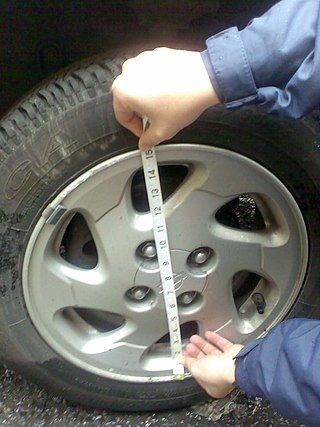
The wheel size for a motor vehicle or similar wheel has a number of parameters.

Rolling resistance, sometimes called rolling friction or rolling drag, is the force resisting the motion when a body rolls on a surface. It is mainly caused by non-elastic effects; that is, not all the energy needed for deformation of the wheel, roadbed, etc., is recovered when the pressure is removed. Two forms of this are hysteresis losses, and permanent (plastic) deformation of the object or the surface. Note that the slippage between the wheel and the surface also results in energy dissipation. Although some researchers have included this term in rolling resistance, some suggest that this dissipation term should be treated separately from rolling resistance because it is due to the applied torque to the wheel and the resultant slip between the wheel and ground, which is called slip loss or slip resistance. In addition, only the so-called slip resistance involves friction, therefore the name "rolling friction" is to an extent a misnomer.

Gear ratios of bicycles are relative measures of bicycle gearing giving an indication of the mechanical advantage of different gears, which combined with the wheel diameter determines how far the bicycle advances per pedal or crank revolution.

ISO 5775 is an international standard for labeling the size of bicycle tires and rims. The system used was originally developed by the European Tyre and Rim Technical Organisation (ETRTO). It is designed to make tire sizing consistent and clear. It replaces overlapping informal systems that ambiguously distinguished between sizes. For example, at least 6 different "26 inch" sizes exist, and "27 inch" wheels have a larger diameter than American "28 inch" wheels. The Japanese Industrial Standards Committee also cooperates with ISO 5775. The corresponding Japanese standards are JIS D 9112 for tires and JIS D 9421 for rims.

Snow chains, or tire chains, are devices fitted to the tires of vehicles to provide increased traction when driving through snow and ice.

The rim is the "outer edge of a wheel, holding the tire". It makes up the outer circular design of the wheel on which the inside edge of the tire is mounted on vehicles such as automobiles. For example, on a bicycle wheel the rim is a large hoop attached to the outer ends of the spokes of the wheel that holds the tire and tube. In cross-section, the rim is deep in the center and shallow at the outer edges, thus forming a "U" shape that supports the bead of the tire casing.
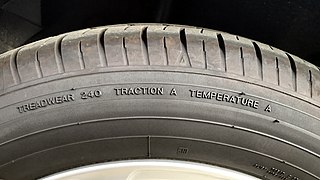
Uniform Tire Quality Grading, commonly abbreviated as UTQG, is a set of standards for passenger car tires that measures a tire's treadwear, temperature resistance and traction. The UTQG was created by the National Highway Traffic Safety Administration in 1978, a branch of the United States Department of Transportation (DOT). All passenger car tires manufactured for sale in the United States since March 31, 1979 are federally mandated to have the UTQG ratings on their sidewall as part of the DOT approval process, in which non-DOT approved tires are not legal for street use in the United States. Light truck tires are not required to have a UTQG. It is not to be confused with the tire code, a supplemental and global standard measuring tire dimensions, load-bearing ability and maximum speed, maintained by tire industry trade organizations and the International Organization for Standardization.
Plus sizing is the practice of replacing an automotive wheel with one of a larger diameter fitted with a new tire of lower aspect ratio so that the new tire has close to the same diameter and circumference as the original tire to minimize any changes in speedometer accuracy, torque and traction control, while reducing sidewall flex and (generally) increasing cornering ability.
Tire uniformity refers to the dynamic mechanical properties of pneumatic tires as strictly defined by a set of measurement standards and test conditions accepted by global tire and car makers.

Formula One tyres play a significant role in the performance of a Formula One car. The tyres have undergone major changes throughout the history of Formula One with different manufacturers and specifications used in the sport.

A bicycle tire is a tire that fits on the wheel of a bicycle or similar vehicle. These tires may also be used on tricycles, wheelchairs, and handcycles, frequently for racing. Bicycle tires provide an important source of suspension, generate the lateral forces necessary for balancing and turning, and generate the longitudinal forces necessary for propulsion and braking. Although the use of a pneumatic tire greatly reduces rolling resistance compared to the use of a rigid wheel or solid tire, the tires are still typically the second largest source, after wind resistance, of power consumption on a level road. The modern detachable pneumatic bicycle tire contributed to the popularity and eventual dominance of the safety bicycle.

The Michelin PAX is an automobile run-flat tire system that utilizes a special type of rim and tire to allow temporary use of a wheel if its tire is punctured. The core of Michelin's PAX system is the semi-rigid ring installed onto the rim using special equipment. It provides support to the tire and its sidewall to allow emergency operation at limited speed until such time as the tire can be replaced. Cars that use the system include supercars like the Bugatti Veyron EB 16.4, luxury cars like the Rolls-Royce Phantom, and more common vehicles like the Honda Odyssey and Nissan Quest.

A motorcycle tyre is the outer part of motorcycle wheel, attached to the rim, providing traction, resisting wear, absorbing surface irregularities, and allowing the motorcycle to turn via countersteering. The two tyres' contact patches are the motorcycle's connection to the ground, and so are fundamental to the motorcycle's suspension behaviour, and critically affect safety, braking, fuel economy, noise, and rider comfort.

The Tyre Label is a mark for motor vehicle tyres. Manufacturers of tyres for cars, light and heavy trucks must specify fuel consumption, wet grip and noise classification of every tyre sold in EU market starting in November 2012.

The following outline is provided as an overview of and topical guide to tires:


